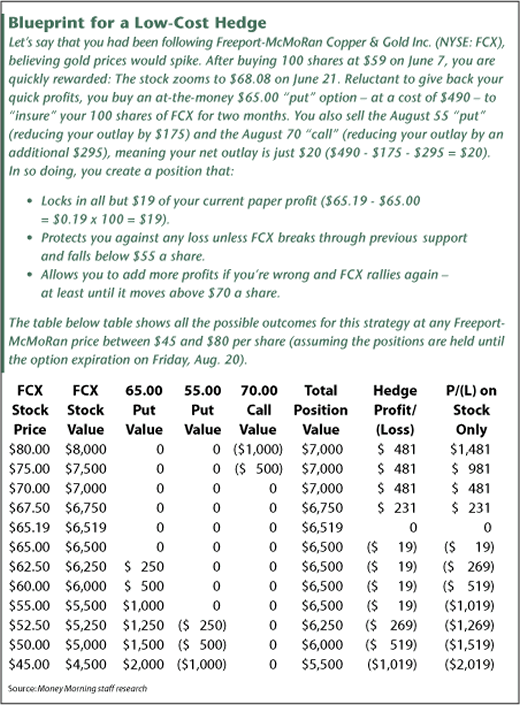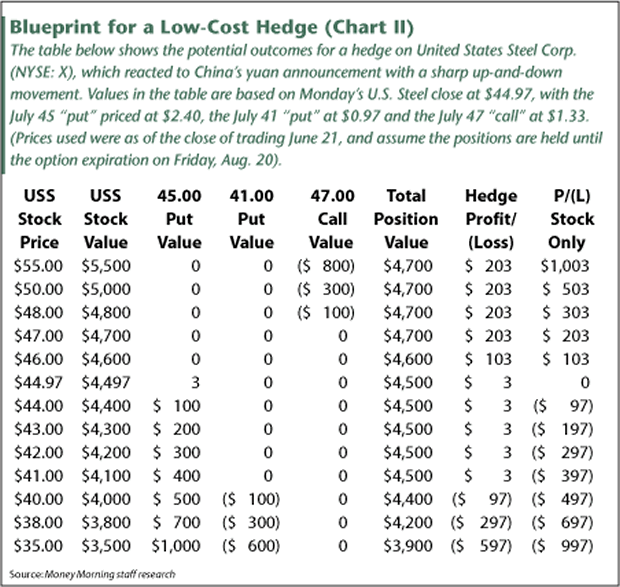How to Use Stock Options to Insure Your Holdings Against Short-Term Pullbacks
Stock-Markets / Options & Warrants Jun 29, 2010 - 06:32 AM GMTBy: Money_Morning
 Larry D. Spears writes: Stock options are among the most versatile tools available to investors. They can be used as a low-cost way to speculate on expected price movements, generate added income on stock holdings, and to lock in gains on profitable positions or hedge against market reversals.
Larry D. Spears writes: Stock options are among the most versatile tools available to investors. They can be used as a low-cost way to speculate on expected price movements, generate added income on stock holdings, and to lock in gains on profitable positions or hedge against market reversals.
The latter strategy typically involves buying at-the-money put options on your long stock positions. This creates a situation akin to an "insurance policy" in that your profit on the put options will offset most or all of the loss on your stock should prices turn lower during the life of the option.
Such hedges have particular appeal in times of excess volatility such as the market has seen in recent months - but there is one problem. Because high volatility increases risk levels, option premiums tend to rise sharply, making the purchase of such "insurance" extremely expensive.
For example, on only a moderately volatile stock, an at-the-money put option with two months of life left currently costs around $500 for each 100 shares. That means the stock price would have to fall more than $5.00 a share before the insurance provided by the put would kick in.
Fortunately, there is a solution for this problem - a way to structure an option hedge that will give you virtually instant downside protection and do so at little or no cost.
What you do is buy the protective at-the-money put, as in the basic strategy, and simultaneously sell (or "write") both a deep out-of-the-money put and an out-of-the-money call option.
The sale of the put creates a bearish spread that will insure your stock position down to the strike price of the put you sell, offsetting any drop in the price of the underlying shares.

The sale of the call brings in enough added money to fully offset the cost of the put you buy for protection, while also allowing you to pick up a limited amount of additional profit should your assessment prove wrong and the stock price continue to rise.
The position carries no additional margin requirement because the stock you hold "covers" the call you sell, and the at-the-money put you buy as insurance covers the put you sell.
If you're not entirely familiar with options and their terminology, a couple of examples should help clarify how to structure the strategy and how it works. (For simplicity and ease of calculation we'll use a 100-share lot of stock and single options in our examples, the first of which is based on actual prices available on Tuesday, June 22.)
Assume you'd been watching Freeport-McMoRan Copper & Gold Inc. (NYSE: FCX), hoping to buy in for a play on the rising price of metals, particularly gold. The stock had been falling for more than a month, but on June 7 it bounced sharply off a six-month low and you viewed this as a signal to act, buying 100 shares at $59.
You were quickly rewarded as the stock climbed more than $9 per share in just two weeks, including a jump of $2.18 a share to $68.08 on June 21, when all the metals rallied on China's decision to let the yuan appreciate against the dollar. However, you got worried the next day when FCX failed to hold its gains, dropping back to just $65.19 a share.
Reluctant to give back your quick profits, you decided to buy an at-the-money $65.00 put option to lock in your gains. However, a glance at the option price tables showed the August 65 put priced at $4.90. That meant it would cost $490 to "insure" your 100-shares of FCX for two months, and the insurance wouldn't even pay off until the price of Freeport-McMoRan fell to $60.10 ($65.00 - $4.90 = $60.10) - thus locking in only $110 of your current profit.
That hardly seemed worth the trouble, but a look at some other option prices presented an alternative. The August 55 put was priced at $1.75 ($175 for the full contract) and the August 70 call option was quoted at $2.95 ($295). If, in addition to buying the August 65 put, you also sold the August 55 put and the August 70 call, your net cost would be reduced to just $20 ($490 - $175 - $295 = $20).
Even better, you would be creating a position that:
•Locked in all but $19 of your current paper profit ($65.19 - $65.00 = $0.19 x 100 = $19).
•Protected you against any loss unless FCX broke through previous support and fell below $55 a share.
•Allowed you to add more profits if you proved wrong and FCX rallied again - at least until it moved above $70 a share.
To clarify these advantages, the following table shows all the possible outcomes for this strategy at any Freeport-McMoRan price between $45 and $80 per share (assuming the positions are held until the option expiration on Friday, August 20).

The strategy will work equally well across a shorter time frame with lower-priced stocks, though the amount of downside protection will be reduced somewhat by the smaller premiums for the shorter-term options.
The table above shows the potential outcomes for a hedge on United States Steel Corp. (NYSE: X), which also reacted to China's yuan announcement with a sharp up-and-down movement. Values in the table are based on Monday's U.S. Steel close at $44.97, with the July 45 put priced at $2.40, the July 41 put at $0.97 and the July 47 call at $1.33.
Obviously, if your concerns prove to be unfounded and the stock price resumes its upward course, this strategy will limit your future profits (unless you buy back the call you sold). However, if you have gains on an existing position - or are worried about a pullback on a holding that hasn't yet made an upward move - this strategy can be a highly effective means of protecting yourself.
And, depending on the strike prices and premiums of the out-of-the-money options you choose to sell, you can get that protection at virtually no cost.
Source : http://moneymorning.com/2010/06/29/stock-options/
Money Morning/The Money Map Report
©2010 Monument Street Publishing. All Rights Reserved. Protected by copyright laws of the United States and international treaties. Any reproduction, copying, or redistribution (electronic or otherwise, including on the world wide web), of content from this website, in whole or in part, is strictly prohibited without the express written permission of Monument Street Publishing. 105 West Monument Street, Baltimore MD 21201, Email: customerservice@moneymorning.com
Disclaimer: Nothing published by Money Morning should be considered personalized investment advice. Although our employees may answer your general customer service questions, they are not licensed under securities laws to address your particular investment situation. No communication by our employees to you should be deemed as personalized investent advice. We expressly forbid our writers from having a financial interest in any security recommended to our readers. All of our employees and agents must wait 24 hours after on-line publication, or 72 hours after the mailing of printed-only publication prior to following an initial recommendation. Any investments recommended by Money Morning should be made only after consulting with your investment advisor and only after reviewing the prospectus or financial statements of the company.
Money Morning Archive |
© 2005-2022 http://www.MarketOracle.co.uk - The Market Oracle is a FREE Daily Financial Markets Analysis & Forecasting online publication.



